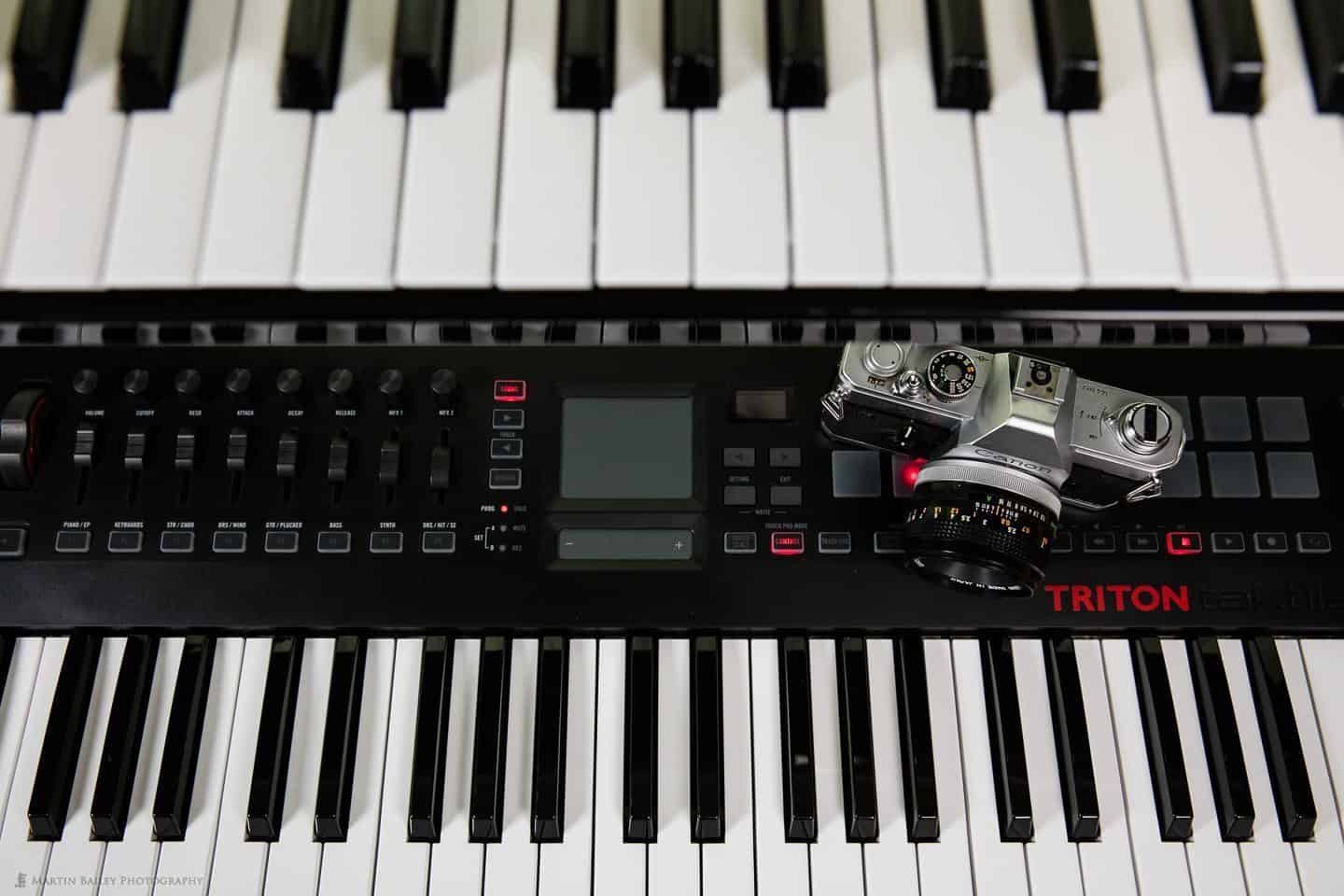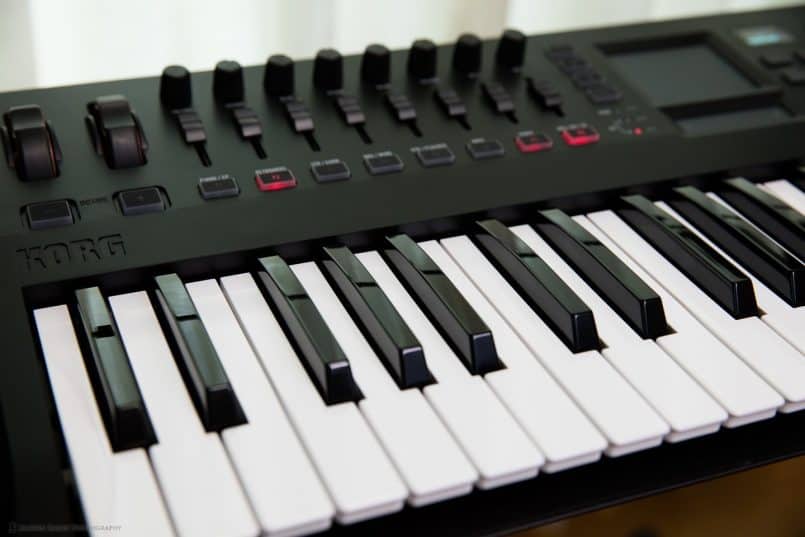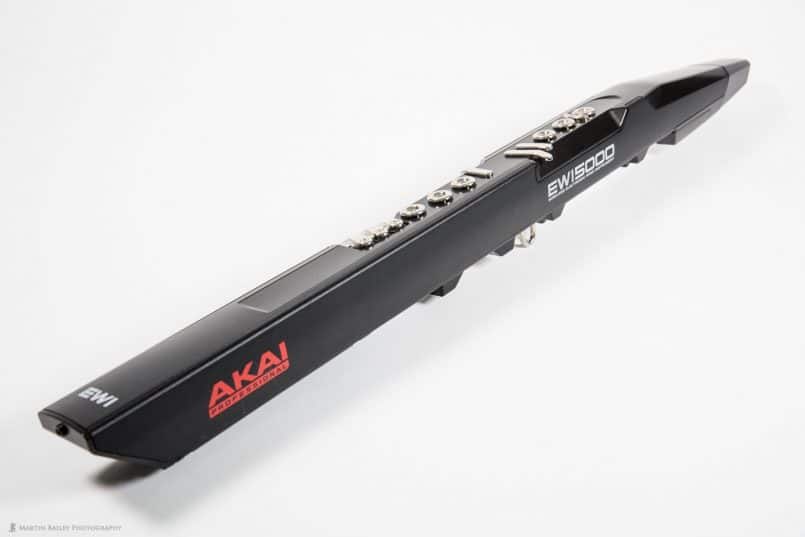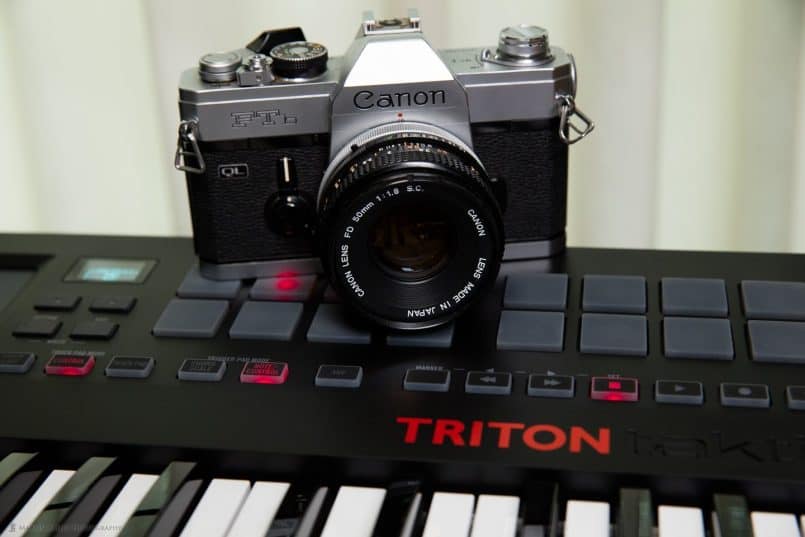Creativity is something that most people struggle with, and for good or bad, technology has changed everything in recent decades, and this is adding to the problem for some but is incredibly enabling at the same time. The digital age has created its own unique dilemmas, and as we’ll continue to explore today, you’ll see that photographers are not alone in this.
I got a bit carried away with this topic, so I’ve split it into two parts. If you didn’t already check out part one, you can find it here.
We Get Excited by the Equipment (13:34)
OK, so I’m still only 13 minutes into this conversation between musicians on Ableton.com, and finding so many parallels that I am not making much progress, so I’m going to pick up the pace a little, otherwise this would end up being a four part series. At this point though, Young Guru mentioned how easy it is to get excited by the equipment, and that’s exactly the same for many photographers.
I don’t care how much people talk about photography not being about the gear, on some level it is always going to be about the gear. We can’t make a photograph without some gear. Of course, I agree that you don’t need the best gear to make beautiful photographs, but we all use gear in our work, and at some level, we enjoy that gear, so let’s get over the “it’s not about the gear” statements.
Guru also mentions how the limitations of early equipment made us creative. This is also true of photography. I think it’s great when we are given new tools that help us to overcome previous limitations, but when limitations are there, I think we enjoy finding ways to overcome them, and the art we create in the process can be liberating. I’m not a fan of HDR photography, but look how popular that became, despite it really just being a way of overcoming the relatively compact dynamic range of early DSLR cameras.
You could argue of course, that it would have been possible to capture the majority of HDR photographs that have been created now with one frame, but at some point, it became more about the resulting look than about overcome the limitation. When I talk to students these days that I see habitually making HDR images, I ask them if the process is feeding their creativity. If the act of shooting multiple frames and merging them together and tone-mapping, or the final look is a part of what get’s the photographer out there, then it’s a good thing.
Digital Doesn’t Sound (Look) As Good! (14:09)
Guru talks about the analog guys and how they say that digital sounds so crappy. You’ve heard this too, right? The film shooter that will try to tell you that the quality of a 35mm negative or positive slide is better than digital. Yes it was, until we hit about 10 megapixels, and then the tables turned. The resolution that we can get from a digital photograph captured with quality lenses is absolutely cleaner than a scanned negative or slide. The latest bodies at 36 and 50 megapixels provide us with images that surpass the resolution of medium format film cameras.
Now, this doesn’t mean that the images are the same. You could argue that there is a certain quality about a film photograph, and in some cases there is, and medium format has totally different optics creating a different look, but you can record that look cleaner with a high resolution medium format digital back than a film back. There is a quality in film that keeps it relevant, and again, if the process feeds your creativity, then go with it, but be happy with your process, rather than trying to tell digital photographers that the quality is not there in digital.
The Process of Playing Became Important to Generate Ideas (18:44)
Phoebe Kiddo mentions that although she likes the cleanness of digital music, she still finds that the process of playing is really important to generate ideas. This is exactly what we were talking about in part one. You have to create to be creative.
Become Good at Problem Finding as Well as Solving!
Phoebe also said that you need to be good at problem finding as well as problem solving. This is golden. Most photographers become pretty good problem solvers, especially when the solution is a nice new shiny piece of equipment, but also as we work in the field. You might have a great subject with a killer composition, but something is missing, so we slap on a neutral density filter and make a long exposure and we remove distractions, as an example. But a lot of the time, understand that there is even a problem that needs solving in the first place, is the largest part of the battle to create better photographs.
Learning the Tools (20:25)
Then, Phoebe goes on to mention how important it is to learn your tools, and also restrict the number of tools that you try to learn, because there is now such a huge range to work with.
This applies to photography when it comes to the importance of learning our tools. I have worked with people in the field that lose opportunities because they don’t understand their tools. In a workshop environment, that’s fine, especially when they let me know and I’m able to help them understand a technique, but when you are out there trying to capture something, the last thing you want to be doing is fumbling with your camera trying to figure out what settings you need or how to change those settings.
The great thing about photography though, is that the main settings are common to whatever camera we’re using. The relationship between shutter speed, aperture and ISO is based on physics and light, and is pretty much unchanged regardless of the camera, so once you know how to change these settings, you can start to use a camera. There are various other features that we need to understand, but when I get a new camera, the first thing I do is sit down for an evening and read the manual, so that I understand how to use any new features that have been introduced.
With music, especially digital music, the instruments can be incredibly complicated. I can waste hours trying to figure out how to send the breath control of my AKAI Professional EWI5000, an electronic wind instrument, to software on my computer. One of the problems is that we can’t see audio, so how it is channeled through the instrument and on the computer gets really confusing really quickly. Keyboards and synthesizers get really complicated as well. This is partly because it’s not what I do, but as a hobbyist, it’s really easy to get lost. So, limiting your tools and really understanding them I think is perhaps more important with digital music than photography.
The result is though, as Phoebe says, the better you understand your tools, the more easily you are able to iterate your ideas. Also the tools themselves start to change the process. I think this is also true for photography. Sometimes a certain camera will feed your creativity in more ways than others. A Leica or some less conspicuous mirror-less cameras for example, are great street photography cameras, and probably become much more a part of the creative process than a regular DSLR might.
We’re Not Here to Just Tinker With Things (22:55)
Guru talks about the importance of actually making music. Unless you are an engineer, let’s not get stuck too much in learning every single detail of the tools from the beginning. First we should sit down and make music with whatever we have, then as we become better at making music, we’ll further learn the tools and how they can help us to improve our music. He goes on to say, “Let’s not forget what we’re here for. We’re not here to just tinker with things.”
Exactly! As the Internet makes so much information available to us, I have come across lots of people with very serious cases of analysis paralysis. It becomes an obsession to learn about every technique and technology available. Now, I don’t want you to think I’m contradicting myself here. Yes, it’s important to learn, and yes, if you enjoy the learning process, then invest as much time as you can into that pursuit, but do not let the learning become the goal.
The goal is to learn enough to get started, and then start. Once you are making photographs, you’ll quickly start to hit problems that need solving, and need to learn something else. As your creativity kicks in more you’ll understand what other parts of the puzzle you need to fill in, but you really have to be doing it to fully understand your path of progression.
The Importance of Listening (25:19)
Matthew Herbert talks about the importance of listening as a way to understand music and hone your craft. In photography, we cannot learn in a vacuum. Looking at other peoples’ work is really important. We don’t necessarily have to emulate that work, although that too can be a good learning exercise, but looking at other photographs helps us to appreciate photography and helps us to build our mental database of possibilities. I think it keeps us sharp, and can also make us hungry. If we see a killer photograph, for me at least, it makes me want to grab my camera and go and shoot something cool too. Or start to plan a project that may not be the same, but hopefully equally creative.
Music is Now Just a Form of Waste (26:27)
James Holden made the statement that there is so much music already, is it really worth polluting the pool with more. He continues on the important point of collaboration, following on from an earlier point from Herbert, and how meeting and working with others gives his work more purpose. Herbert says that we have to accept that music is now a form of waste! We’re just spewing it out and nobody is listening any more. He quoted a statistic from someone from Apple that 75% of the content in iTunes has never been downloaded once.
This is probably for me one of the saddest parts of this conversation. In some ways, I’d say that this is pretty much the same for photography, but the main difference is that photography in it’s easiest form is literally as simple as pointing your phone or camera at something and snapping away. Every one of those snaps doesn’t end up in iTunes though. For someone to go to the trouble to make a piece of music takes much more work than thoughtlessly snapping a photograph.
It’s a Lot Easier Now to Get into Making Music (28:35)
DeSantis poses the question, “If the EDM (Electronic Dance Music) segment of Beat Port is so completely saturated, why is so much music being fed into this machine?” Guru comes back with “Because the access is there and it’s a lot easier now to get into making music. There’s no step, and there are positives and negative to that.” He also says that at same time as we complain about how easy it is to make music now, we asked for this.
Guru goes on to say, “If we want the freedom to be able to upload our songs to the Internet, everyone else is going to have that same access, so now the trick is to figure out how to get above the noise.” He reflects on the importance now of working to get people to your web site or over to iTunes, and he enjoys that process. But if you don’t understand that, as a musician these days, you’re going to be lost.
Sound familiar? I hear this from photographers all the time today. Figuring out how to get noticed and become or even remain important in the photography world is just as big a dilemma to us as it is to musicians, if not more so, because as I say, it’s even easier to make a pretty photo these days that it is to record a whole song. I’m not going to go into my ideas as to how to achieve this, partly because you are reading or listening to part of my answer, but also because I think there are as many answers as there are photographers, but I love thinking about the similarities between music and photography in this respect.
The main answer to this from Guru was to figure a way to do something different. If everyone is doing one thing, do something else. If everyone starts to use the same effect, use something else. Honestly, this is one reason why I have avoided HDR. Too many people use the technique. Plus, it’s too much trouble for me, and I’d prefer for my images to be appreciated for what they are, rather than an effect. I’ve nothing against HDR in other peoples’ work, but it’s not for me.
Live Life (33:23)
Phoebe talks about the important of living life, because it’s these aspects of yourself from other arts or experiences that make your work different. She goes on to talk about how important it is to understand convention and the rules in order to know how to break them. This is also very important in photography. Also, Phones talks about deciding on an aesthetic preference for each project. You don’t have to stick with this for life, but for each record for example. Naivety is also great as it can lead to happy accidents. A lot of young producers create definitive work through not really knowing what they “should” be doing.
Taping Fingers Together to Avoid Playing Too Many Notes (39:18)
Matthew Herbert relays a story about a friend who tapes some of his fingers together to avoid playing too many notes, and hence be different. You’ve heard about people taping a lens at a certain focal length, or only using one prime lens, right? These practices are common between both disciplines, although I feel it would be a little bit more limiting for a pianist.
Herbert also talks about the biggest opportunity of his career, which was to write a piece to be performed on British television, as a celebration of British Jazz, and as he was on tour at the time, he found himself with just three and a half hours to write the piece, from start to finish, including creating a manuscript for delivery. This of course again relates to the value of healthy pressure and its affect on the creative process. Sometimes a deadline or other restriction can be just what you need to pull your creative chords for you.
How Original One Can Be and Authenticity (41:17)
Towards the end, a listener asks a question about originality and authenticity. Guru replies with one of my favorite statements from this conversation. “I can be original all day—everything is different. Every day is completely different. People say that everything under the sun has already been done, but that’s BS. This day hasn’t happened, so you can figure out a way to make those three chords sound completely different from what somebody else is doing and make it your own. Make it original. I don’t like that people say you can’t be original. You absolutely can be original in everything that you do, every single day. The vibration is never the same. If one more person walks into this room it changes the vibration. There is always room to be different.”
This is a very eloquent way of saying something that I’ve said many times over the years. Yes, it’s important to try to be different, but I also think that we bring ourselves to our work, and even if we photograph a scene that has been photographed a million times, we bring ourselves to the scene. Our photographs always contain both what’s in front of the camera, and what’s behind it.
From Presets to Originality (43:30)
There’s another listener question about going from using presets to becoming original. In digital music, it can at first be really difficult to make a synthesizer sound the way you want, so generally people start with presets, but then after a while, they start to tweak the presets or create their own presets from scratch, because if you don’t, you end up using instruments that sound just like everyone else.
The same trap is right here in photography, if you get caught up using presets, if you don’t modify them to your needs and your own taste. Likewise, they are a great way to learn new settings, but I believe that presets should be used more as an means to educate yourself on the possibilities of your software, so that you can understand what the various settings do, and then move on to your own settings from scratch, and finding your own voice. Even if you then save a preset of your new settings, you’ll rarely want to simply blindly apply that to all of your images. They are starting points, not generic fix-all tonics for your photos.
How do You Know When it’s Time to Release Work? (47:30)
The second to last question was about knowing when it’s time to ship, to release work for public consumption. Should we put the work out to keep the flow going, or do we give in to the fear of never feeling as though something is really finished, and therefore keeping it to yourself. Guru’s answer is that a piece is finished when it represents you or you got the emotion out. Some people don’t want to commit for fear of criticism.
It’s not always necessary for your work to be loved by everyone. In fact, I’d say that this is impossible. It’s definitely important to listen to critique, especially from people who’s opinions we trust, but I don’t think it’s necessary to adjust your work to try to please others. To me our work should first and foremost please ourselves. If you can get any photograph to the point where you are truly happy with it, it’s ready to show to people. Also though, there are times when we know it’s not 100% but we have to show it to people to get the feedback required to make it or future work better. Both of these things are going to help us to move forward, but keeping our work on our hard drive and never releasing it doesn’t take us anywhere.
Guru goes on to say that if you don’t put your work out there, you become like Vivian Maier, the prolific and incredibly talented street photographer who’s work was only discovered after she’d died. “The music is for people. Put it out!”, says Guru.
Happy Accidents and Flow (50:42)
The last question was about making mistakes that lead to something great. Sometimes the things that we create are somehow beyond us. Matthew Herbert says that he would be hard pressed to tell us how he created most of his music, because it happened so fast. He finishes a whole piece in an hour and a half. It’s about surrender and abandoning one’s conscious self. Guru adds that it’s not necessary to interpret it as a mistake. It might be something that was not intended, but if you get an emotional response from someone else, that’s a great thing.
You know, when I have to create something, sometimes I can feel pressured. The thought that I have to be creative to order can be paralyzing. But when I pick up the camera, or sit at the computer to write an article, generally, it starts to flow, and before I know it I have something that either matches or hopefully surpasses my expectations. It’s times like this when I believe we’re in that state of flow in which we are at our most creative. It doesn’t always come easily, but you know what, it doesn’t come at all if you don’t start doing what you have to be creative at.
Final Thoughts
OK, so that takes us to the end of the video, so I’d like to relay some final thoughts. It was refreshing to note just how many similarities both of these creative pursuits share. My main observation was how both music and photography have been hurt to a degree by the digital revolution. But if we think about it, I truly believe that the changes we’ve seen in recent decades have opened more doors than they’ve closed.
For some, I know that doors were slammed shut in your face, and there are absolutely less traditional photography related jobs around now than there were 10 to 15 years ago, but the truly creative artist, and more importantly sometimes, the creative business person, has made the most of these new opportunities. I saw opportunities in photography that only opened up to me as the industry changed.
I would not be in business today if it was not for the new technology that enabled me to blog and podcast and reach thousands of people each week with this content. It was simply not possible twenty years ago, and it was barely possible eleven years ago when I started this podcast.
We decide how we deal with change. We can bury our heads in the sand and pretend nothing is happening until someone takes the sand away as well. We can sit around complaining and lamenting the good old days. Or we can accept the new and if possible welcome it with open arms. I can’t say that it’s always easy to make a living from creative pursuits, but it’s more satisfying than anything else I’ve done to make a living so far in my life.
I also think it’s fun to see how the lower cost of entry and abundance of information about both photography and music are flooding the market with content, and making it more difficult to stand out from the crowd. But really, considering what we have right now, would you really like to turn the clocks back 20 years and stop digital photography from happening? I know I wouldn’t. We live in amazing times, and that brings incredible opportunities for both the professional and hobbyist alike. Let’s continue to enjoy the ride, living life to the full, and feeding all of our experiences back into our photography.
Show Notes
The music related conversation on Ableton.com: https://www.ableton.com/en/blog/overcoming-creative-blocks/
Subscribe in iTunes for Enhanced Podcasts delivered automatically to your computer.
Download this Podcast in MP3 format (Audio Only).
Download this Podcast in Enhanced Podcast M4A format. This requires Apple iTunes or Quicktime to view/listen.






0 Comments